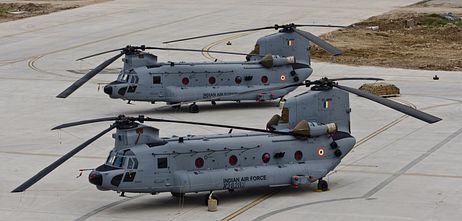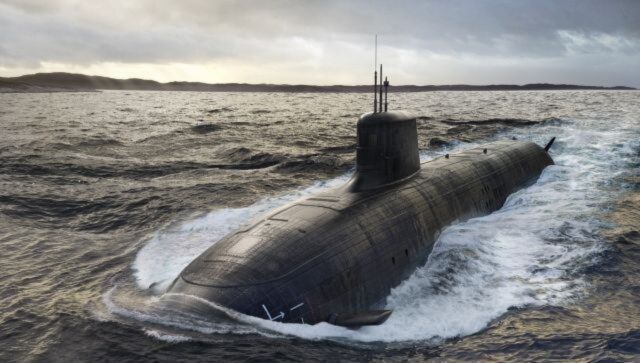SOURCE: AFI


A Punjabi man recently deported from the United States has shed light on what he describes as a “Khalistani racket,” revealing the hollow nature of asylum claims based on political persecution related to the Khalistan movement. In a revealing post on social media, he detailed his experience in court and the subsequent unraveling of his asylum case.
The man, whose identity remains undisclosed for privacy reasons, shared that his deportation orders were issued following his last court hearing. He wrote, “The judge said, you’d be sent in the next two flights. This is my last post, I’m about to close this account so I do not suffer any issues back in India.”
Continue readingSOURCE: RAUNAK KUNDE / NEWS BEAT / IDRW.ORG


Economic Explosives Limited, a subsidiary of the Solar Group of Industries, is reportedly planning to offer the development of a military transport aircraft for the Indian Air Force (IAF). According to sources close to idrw.org, the proposal is still in its early stages, and details about the specific segment of aircraft being targeted remain unclear.
Given that Tata Advanced Systems Limited (TASL) is already engaged in the production of the C-295M transport aircraft for the IAF, it is speculated that Economic Explosives Limited’s project could be aimed at the IAF’s upcoming Medium Transport Aircraft (MTA) program. This program seeks 60 units to replace the ageing An-32 and IL-76 fleets.
Continue readingSOURCE: RAUNAK KUNDE / NEWS BEAT / IDRW.ORG


Tata Advanced Systems Limited (TASL) has approached the Ministry of Defence (MoD) seeking approval to work on a High-Altitude Long-Endurance (HALE) UAV program for the Indian Armed Forces. If approved, TASL would become the first private sector company in India to enter a domain traditionally dominated by the Defence Research and Development Organisation (DRDO), particularly its Aeronautical Development Establishment (ADE) lab.
In the past, TASL proposed converting the manned Grob G 180 aircraft into an unmanned HALE platform. However, the company now aims to develop a completely new unmanned HALE UAV from scratch. According to sources from idrw.org, TASL intends to incorporate off-the-shelf technologies sourced from both domestic and international players to accelerate development.
Continue readingSOURCE: RAUNAK KUNDE / NEWS BEAT / IDRW.ORG


India’s naval strike capabilities are set to receive a significant boost as the Naval Anti-Ship Missile-Medium Range (NASM-MR), showcased as a scaled model at Aero India 2025, prepares to commence developmental trials. This indigenous missile, developed by the Defence Research and Development Organisation (DRDO), is poised to become India’s first air-launched anti-ship missile with a range exceeding 350 km. Unveiled at the prestigious airshow held in Bengaluru, the NASM-MR promises to redefine maritime warfare with its advanced technology and stealth features, strengthening the Indian Navy’s ability to counter threats in contested waters.
The NASM-MR stands out as a high subsonic sea-skimming missile, powered by a scaled-down derivative of the Manik turbofan engine, developed by DRDO’s Gas Turbine Research Establishment (GTRE). This engine, tailored for efficiency and endurance, enables the missile to maintain a high subsonic speed—approaching Mach 0.9—while covering distances over 350 km. This range marks a significant leap over existing indigenous systems like the NASM-SR (55 km) and positions the NASM-MR as a direct competitor to global benchmarks such as the American Harpoon and the French Exocet while offering greater reach than many contemporaries.
Continue readingSOURCE: AFI


The Pentagon has expressed a strong interest in seeing the Indian Air Force (IAF) join the ranks of nations operating the F-35A Lightning II, highlighting the strategic benefits this could bring to any potential coalition efforts against Chinese aggression, either alongside Taiwan or directly involving India. This push comes at a time when geopolitical tensions in the Indo-Pacific region are escalating, and the need for a cohesive military strategy among allies is more critical than ever.
The F-35A, Lockheed Martin’s fifth-generation stealth fighter, is not just an aircraft but a pivotal component of modern warfare, offering unmatched capabilities in air superiority, strike missions, and intelligence gathering. As the only Quad member without the F-35A in its fleet or any other American jet fighters, India’s integration into this elite group would significantly enhance interoperability with U.S. and allied forces, particularly in a coalition scenario against China.
Continue readingSOURCE: AFI


In a recent interaction with idrw.org, a Ministry of Defence (MoD) official shed light on the ongoing delays in the Indian Air Force’s (IAF) ambitious Multi-Role Fighter Aircraft (MRFA) tender. The program, aimed at procuring 114 advanced fighter jets to bolster India’s aerial combat capabilities, has been languishing since the issuance of the Request for Information (RFI) several years ago.
The crux of the delay, as per the MoD official, centers around the IAF’s yet-to-be-finalized Request for Proposal (RFP). The RFP is a critical document in defense procurement, detailing the specific requirements and conditions under which the bidding process will occur.
Continue readingSOURCE: AFI


In a significant development for India’s military procurement strategy, there are strong indications that the Indian Air Force (IAF) might reconsider its plans to acquire additional CH-47F(I) Chinook heavy-lift helicopters. This reassessment comes amid pressure from the Trump administration, which has been keen on enhancing defense ties and promoting U.S. defense exports.
In September 2015, India signed a landmark deal with U.S. aerospace giant Boeing to procure 15 CH-47F(I) Chinook helicopters for approximately $1.1 billion. This contract included an option clause allowing India to purchase an additional seven helicopters at the same price point if needed. However, due to cost considerations, the IAF did not exercise this option initially, focusing instead on other strategic acquisitions.
Continue readingSOURCE: AFI


The Indian Navy has officially placed orders for the Kalibr-PL anti-ship cruise missiles to enhance the capabilities of its Kilo-class submarine fleet, signaling a strategic move to bolster its naval strike capabilities. The Kalibr-PL, specifically the 3M-14K variant, is tailored for sub-surface launches, akin to the 3M-14T Kalibr-NK, which is deployed from surface ships but serves a land-attack role.
The Kalibr-PL missiles, with their variant designed for submarine deployment, have been seen in action when launched from improved Kilo-class submarines. This integration into the Indian Navy’s arsenal comes as part of a broader modernization effort, aiming to equip its underwater fleet with state-of-the-art weaponry capable of engaging targets at extended ranges.
Continue readingSOURCE: IDRW.ORG
)

India’s decision to prioritize the development of nuclear-powered attack submarines (SSNs) over acquiring additional aircraft carriers represents a significant shift in naval strategy, according to Dr. Elizabeth Buchanan, Senior Fellow at the Australian Strategic Policy Institute (ASPI). This response follows reports that the Ministry of Defence (MoD) has halted plans for procuring a third aircraft carrier in favor of accelerating the indigenous SSN program.
Dr. Buchanan stated, “India’s decision to throw everything at the SSN program signals a major doctrinal shift.” The move reflects a reassessment of India’s strategic priorities, emphasizing undersea warfare capabilities as a means to counter emerging regional threats and enhance naval deterrence.
Continue readingSOURCE: IDRW.ORG


In a significant stride toward self-reliance in defense technology, Astra Microwave Products Limited (AMPL), a Hyderabad-based leader in RF and microwave systems, has showcased its indigenously developed S-Band Active Antenna Array Unit (AAAU) Radiating Plate Assembly (RPA).
This cutting-edge system, realized in collaboration with the Electronics and Radar Development Establishment (LRDE), a laboratory under the Defence Research and Development Organisation (DRDO), represents a milestone in India’s radar technology development. The AAAU was demonstrated at AMPL’s state-of-the-art Radar Research and Development (R&D) facility in Bengaluru, where it underwent rigorous testing and validation, highlighting India’s growing capabilities in advanced defense electronics.
Continue readingSOURCE: AFI


The Defence Research and Development Organisation (DRDO) has announced that its Very Short-Range Air Defence System (VSHORADS) is now set for Army user trials, with the Indian Air Force (IAF) also participating, after three successful flight trials conducted off the coast of Odisha. These trials, which took place in Chandipur, demonstrated the system’s capability against high-speed, low-altitude threats, marking a significant step forward in India’s defense capabilities.
The trials involved engaging high-speed targets simulating enemy aircraft or drones flying at very low altitudes, a scenario where air defense systems are often put to the test. The VSHORADS successfully intercepted these targets, proving its effectiveness in real-world combat conditions.
Continue readingSOURCE: AFI


The Pakistan Air Force (PAF) is at a critical juncture, dealing with what could be described as a ticking time bomb regarding its aging fleet of fighter jets. With significant portions of its combat aircraft nearing or exceeding their operational life expectancy, the PAF is under immense pressure to phase out these aging assets while simultaneously modernizing its air capabilities to keep pace with regional threats and technological advancements.
Mirage III/V Dates back to the 1960s and 1970s, the PAF still operates over 150 Mirage-III/5 jets. These French-origin aircraft, now over 50 years old, are rapidly approaching the end of their airframe service life. The manufacturer, Dassault, ceased production of spare parts decades ago, severely limiting maintenance and operational capabilities.
Continue readingSOURCE: AFI


A viral video circulating on Instagram has sparked significant interest in the defense community, showcasing a new armoured BEML Tatra 6×6 truck. Bharat Earth Movers Limited (BEML), a leading Indian defense manufacturer, is reportedly developing this advanced vehicle, which features a newly designed 4-door armoured cabin for a 6×6 Mounted Gun System (MGS). This development is set to enhance the operational capabilities of the Indian armed forces, particularly in high-mobility and combat scenarios.
The new armoured truck is built on the existing BEML-Tatra 6×6 High Mobility Vehicle (HMV) chassis, renowned for its ruggedness and adaptability across diverse terrains. The 6×6 configuration ensures superior off-road performance, making it ideal for military applications in challenging environments.
Continue readingSOURCE: AFI


In a remarkable showcase of indigenous defense technology, an India-made sniper rifle has reportedly outperformed the iconic American Barrett in a high-profile competition. The National Security Guard (NSG), India’s elite counter-terrorism force, clinched victory in the All India Police Commando Competition using the .338 Saber, a sniper rifle designed and manufactured by Bengaluru-based SSS Defence. This triumph has spotlighted India’s growing prowess in the global arms manufacturing arena.
The competition, which pits some of India’s finest commando units against one another, saw the NSG take on formidable opponents, including Force One of the Maharashtra Police. Force One, equipped with the American-made Barrett .50 Cal—a sniper rifle widely regarded as one of the best in the world—secured second place. Despite the Barrett’s reputation for power and precision, the .338 Saber proved superior in this contest, underscoring the capabilities of India’s homegrown technology.
Continue readingSOURCE: AFI


Tata Power Company Limited, a leading name in India’s energy sector, has taken a significant step towards diversifying its energy portfolio by shortlisting six potential locations for nuclear power projects. This move comes as part of the company’s strategic expansion into the nuclear energy sector, which is seen as a cornerstone for sustainable and clean energy solutions in India.
According to Praveer Sinha, CEO and MD of Tata Power, the company has rigorously evaluated over 10 sites across the nation. After careful assessment, six of these have been selected as viable options for establishing nuclear power plants. This decision aligns with the broader national objective of enhancing energy security through nuclear power, which offers benefits like reduced carbon emissions and a reliable power supply.
Continue reading